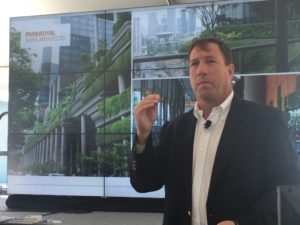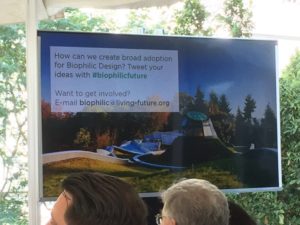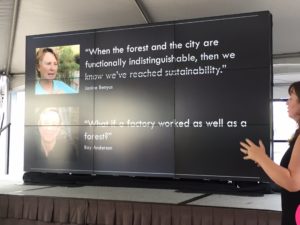

News
Recap: Terrapin at Greenbuild 2016!
Allison Bernett
Share
This year, Terrapin traveled across the country for a bright and sunny Greenbuild 2016 in Los Angeles. The conference reflected the newest directions of the industry: an emphasis on technology and data balanced by a focus on wellness, equity, community prosperity, and biophilic design.

Bill speaking about biophilic design in the Parkroyal hotel by WOHA. Photo courtesy Jodi Smits Anderson via Twitter.
Embracing the mild climate, Bill spoke at the outdoor pavilion. With palm trees, hummingbirds, and sunshine as a backdrop, talking about biophilia seemed very appropriate! Bill spoke along with Amanda Sturgeon of the International Living Future Institute, Vivian Loftness of Carnegie Mellon University, and Richard Piacentini of the Phipps Conservatory and Botanic Gardens. The session was part of a continuing effort to promote biophilic design through the Biophilic Design Initiative, and to communicate new tools and resources for designers, building owners, and municipalities who want to implement this evidence-based design method.

Ways to get involved in the Biophilic Design Initiative. Photo courtesy Hnedak Bobo Group via Twitter.
Chris moderated a panel with Paolo Parigi of Stanford University and Erin Barnes of ioby talking about “The Shared City: The Sharing Economy in the Evolution of the City.” Both Paolo’s research and Erin’s project examples demonstrated how sharing economies override inherent biases and bring people together. Paolo focused on how establishing trust and maintaining a reputation system are critical to successful online platforms like Airbnb. Erin shared stories of ioby-supported community events and projects. She emphasized how designers and public agencies need to listen to communities and support what is already happening there.

Interface’s “Factory as a Forest” project based on the vision of Janine Benyus and Ray Anderson. Photo courtesy of Interface via Twitter.
The Terrapin team also enjoyed many other sessions. Our friends at Interface, Biomimicry 3.8, and the International Living Future Institute talked about learning from nature’s regenerative model for both products, processes, and whole factories. James Connelly reviewed the Living Product Challenge, while Erin Meezan and Nicole Miller discussed the pilot phase of Interface’s Factory as a Forest project, which Biomimicry 3.8 and Terrapin are helping to develop and implement. The concept relies on Janine Benyus’ vision of factories performing like their local ecosystems.
Susie Teal from COOKFOX Architects, along with Steven Tupu of Scape and Gwen Schantz of the Brooklyn Grange discussed the opportunities of green roofs and urban farming. Susie presented examples of COOKFOX’s stunning biophilic architecture around the city, such as 150 Charles Street and how the addition of green terraces boosted the desirability of the apartments.
We were also excited to hear Ann Sussman discuss her book, Cognitive Architecture. In the session, she made the case that we should consider human evolutionary biology when designing the built environment. She argued that the better we understand how humans are wired to respond to our surroundings, the better we can design environments. When showing the audience two different spaces side by side, the responses were just about unanimous – we all agreed on which spaces were preferable. We’re looking forward to using this research to inform our work in biophilic design.
Overall, it was refreshing to hear biophilic design and human wellness discussed in so many presentations, as well as see a number of community and regional scale approaches to sustainable design. We had a fantastic time reconnecting with old colleagues, meeting new ones, and learning about the spectrum of research and projects happening in green building.
Filed under:
Allison Bernett
Allison Bernett is an associate project manager and the public relations coordinator for Terrapin Bright Green. She graduated summa cum laude from Washington University in St. Louis with a double major in architecture and biology. Allison’s interests focus on architecture, sustainability, and bioinspired innovation.
Topics
- Environmental Values
- Speaking
- LEED
- Terrapin Team
- Phoebe
- Community Development
- Greenbuild
- Technology
- Biophilic Design Interactive
- Catie Ryan
- Spanish
- Hebrew
- French
- Portuguese
- Publications
- Occupant Comfort
- Materials Science
- Conference
- Psychoacoustics
- Education
- Workshop
- Mass Timber
- Transit
- Carbon Strategy
- connection with natural materials
- interior design
- inspirational hero
- biophilia
- economics of biophilia
- Sustainability
- wood
- case studies
- Systems Integration
- Biophilic Design
- Commercial
- Net Zero
- Resorts & Hospitality
- Energy Utilization
- Water Management
- Corporations and Institutions
- Institutional
- Ecosystem Science
- Green Guidelines
- Profitability
- Climate Resiliency
- Health & Wellbeing
- Indoor Environmental Quality
- Building Performance
- Bioinspired Innovation
- Biodiversity
- Residential
- Master Planning
- Architects and Designers
- Developers and Building Owners
- Governments and NGOs
- Urban Design
- Product Development
- Original Research
- Manufacturing
- Industrial Ecology
- Resource Management
- Sustainability Plans
- Health Care
- Carbon Neutrality


